Please Take Note: This is a review of the game’s final prototype. The art, game bits, and the rules discussed are all subject to change. The game is being reviewed on the components and the rules provided with the understanding that “what you see is not what you might get” when the game is published. If you like what you read and want to learn more, we encourage you to visit the game’s website or visit the Kickstarter campaign. Now that we have all that disclaimer junk out of the way, on with the review!
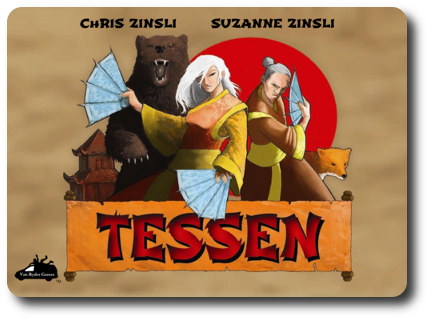
The Basics:
- For ages 6 and up (publisher suggests 12+)
- For 2 players
- Approximately 15 minutes to complete
Geek Skills:
- Active Listening & Communication
- Counting & Math
- Logical & Critical Decision Making
- Pattern/Color Matching
- Strategy & Tactics
- Risk vs. Reward
- Hand/Resource Management
- Reflex & Speed
Learning Curve:
- Child – Easy
- Adult – Easy
Theme & Narrative:
- Honor your clan and obtain the Shogun’s favor by going on a mystical animal hunt
Endorsements:
- Gamer Geek approved!
- Parent Geek approved!
- Child Geek approved!
Overview
For generations, the great clans have fought. Unrest and lawlessness soon followed in the wake of the constant violence. The Shogun was furious and called the leaders of the clans to attend him. He proposed a trial of wits and skill that would pit the clans’ best against each other. To the victor would go the Shogun’s favor. Honor bound, the clans sheathed their swords, but their ancient feud was far from over.
Tessen, designed by Chris Zinsli, Suzanne Zinsli, and to be published by Van Ryder Games, will reportedly be comprised of 2 decks of 42 cards (1 deck per player). Each deck contains 8 different Animal types (4 of each), 9 Warriors, and 1 Super Warrior. The cards in each deck are the same. As this is a review of a prepublished game, we will not comment on the game component quality.
Game Set Up
To set up the game, first separate the two decks of cards. Each deck has its own unique card backing color making this an easy exercise. When done, give each player one of the two decks.
Second, have each player shuffle their own deck and place it to their immediate left, face-down. This is the player’s draw deck.
That’s it for game set up. Determine how many rounds will be played (3 or 5) and begin. Time to show the Shogun the strength of your clan!
The Lay of the Land
Tessen is a fast game of card draws, plays, and decisions. The game play set up and layout has been designed to be as efficient as possible. If the game play area is laid out as the image below shows, players will always draw from their left (their draw deck and their opponent’s Animal discard pile), play to their front, score to their right, and discard to their right. This allows for a smooth transition of card plays throughout the entire game.
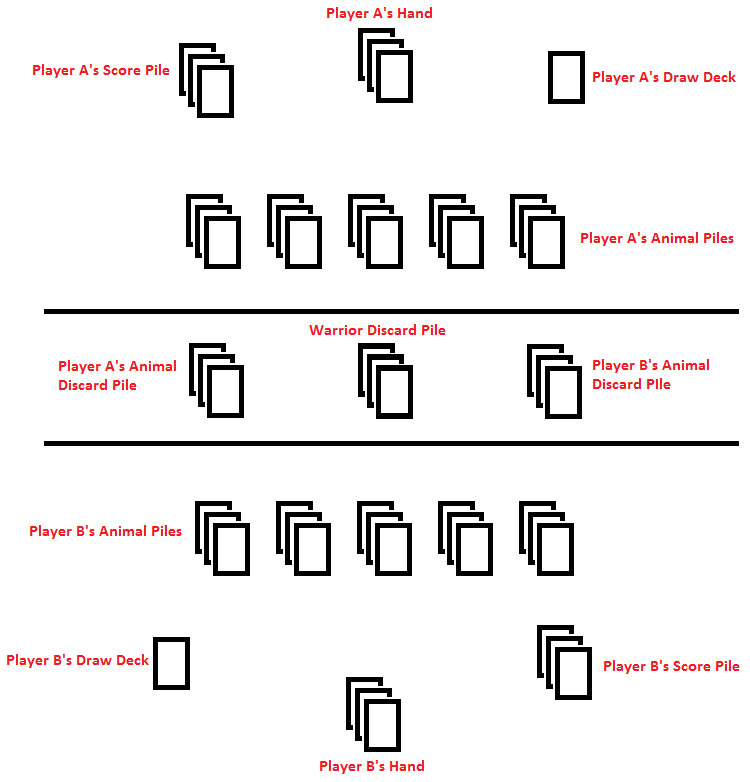
Animals and Warriors
Each Tessen deck has the same number and type of cards. The information on the cards is minimal on purpose so as to keep the player’s focus on the game as a whole instead of individual cards. Still, a player will need to recognize what cards they currently hold at a glance so as to practice good hand management and make important decisions.
The most numerous cards in the game are the Animal cards. There are 8 different Animal types. These include Bear, Tsushima Leopard Cat, Crane, Fox, Red Panda, Monkey, Pheasant, and Stag. Each Animal type has four cards each. Knowing or naming the animal in the game is not important. What is important is matching the symbols found on the upper left and lower right corners on the card’s face. These are used to match Animal cards when creating Animal piles.
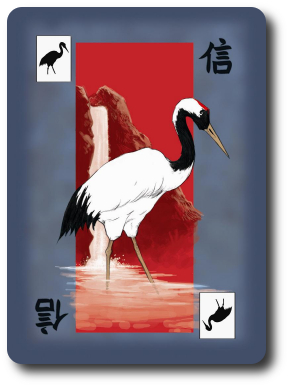
The only other cards in the decks are the Warriors. There are two Warrior types in each deck. These are the standard Warrior (9 in total) and the Super Warrior (1 in total). The standard Warrior card has a red tessen (a fan used in warfare) found on the upper left and lower right hand corners on the card’s face. The Super Warrior card has a blue tessen found on the upper left and the lower right hand corners on the card’s face.
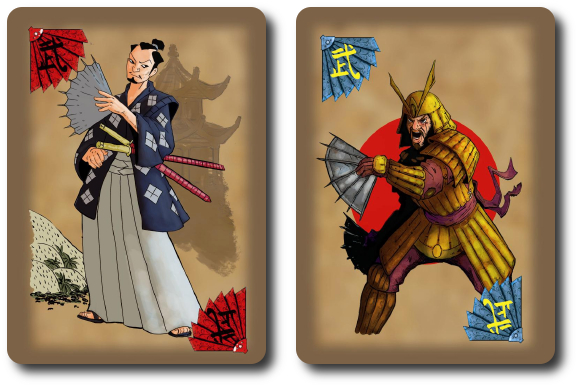
Mystical Animal Hunt
Tessen is played in rounds with a single came consisting of either 3 or 5 rounds (determined by the players before the game is started). Game play between the two opponents is simultaneous throughout the entire round. During a round, players can take several actions which are summarized here. A player can take any of these actions anytime during the round and as many times as they like as long as they have the cards.
Draw Cards
A player has two sources of cards to select from and use during the game. The first is their own draw deck which contains the same number and type of cards as their opponent. If the game was set up as described above, this deck is face-down to the player’s immediate left. The second is their opponent’s Animal discard pile which should be the leftmost discard pile in the middle of the playing area if the example game playing area provided above is used.
Discard Cards
A player can only ever have 5 cards in their hand and will need to discard down to 5 before they take any other actions. A player cannot have 6 or more cards and play them or draw new cards until they only have 5 cards in their hand, for example. When a player does have 6 or more cards, the only action they can take is discarding Animal cards to their Animal discard pile which should be the rightmost discard pile in the middle of the playing area if the example game playing area provided above is used. Discarded Animal cards are placed in the Animal discard pile face-up.
Play Animals
A player can have up to 5 different Animal card type piles in front of them at a time . All five Animal piles are played face-up in front of the player and each pile must contain the same Animal type. For example, a player could have a Stag, Monkey, Crane, Fox, and Bear Animal types in front of them. When an Animal card is played in front of the player, it must first be played to an existing pile if the same Animal type is already showing. If not, it can only be added if there are less than 5 Animal piles in play in front of the player already. Otherwise, the player must keep the Animal card in their hand for later use or discard it to their Animal discard pile.
Score Animals
When an Animal pile in front of a player has 3 or more Animal cards of the same type, it can be scored. This is done by the player shouting “Save!” The player then takes the entire Animal pile and sets it to their immediate right, face-up. This is the player’s Score pile. These Animal cards are out of play for the duration of the round and will count as points at the end of the round.
Use Warriors
Each player starts the game with 9 Warrior cards and 1 Super Warrior card. These are used to take special actions and “pause” the game until the Warrior cards being played are resolved. A player can complete an action they started right before or at the same time the Warrior card is played before resolving the Warrior card’s actions. When in play, Super Warrior and Warrior cards can counter other Warrior cards, but a Super Warrior card can only be countered by another Super Warrior card when attacking.
- Attack: The player shouts “Attack!” and the Warrior card is set in front of an opponent’s Animal pile still in play (not scored) or one of the yet unclaimed 5 possible locations for an Animal pile. There are two possible outcomes to this action. The first outcome is that the opponent cannot or chooses not to defend against the attack (referred to as “Conceding”). If such is the case, all the Animal cards in the successfully attacked Animal pile are collected by the player and either added to an existing Animal pile owned by the player, create a new Animal pile, or placed in the player’s Animal discard pile. Never to the player’s hand and never given back to the opponent! The Warrior card is then placed and holds the opponent’s spot where the Animal pile was located or would have been located. This spot is now locked until cleared. Game play now resumes. The second outcome is that the opponent counters with a Warrior card of their own (referred to as “Defending”). Both Warrior cards are placed in the Warrior discard pile which should be the centermost discard pile in the middle of the playing area if the example game playing area provided above is used. Discarded Warrior cards are placed in the Warrior discard pile face-up. Game play now resumes.
- Clear: The player shouts “Clear!” and then discards one Warrior card from their hand and one Warrior or Super Warrior card placed by their opponent that is currently locking an Animal pile location, placing both in the Warrior discard pile.
Ending the Round
Game play continues with players taking simultaneous actions until a player draws the last card from their draw deck. When a player does, they shout “Tessen!” The round immediately ends and no more actions can be taken. Any cards left in the player’s hand are not playable and are placed in the player’s Animal discard pile.
Players now count the Animal cards they scored, receiving one point per Animal card in their Score pile.
The player with the most points wins the round. In case of a tie, the player who drew the last card wins. A new round now begins by completing the set up steps noted above; however, the player who wins the round must first remove one of their Warrior cards or their Super Warrior card (player’s choice) from the game permanently.
Winning the Shogun’s Favor
A single game could be the best of 3 or the best of 5 rounds, depending on what the players decided prior to beginning the game. When the last round is played, the player who won the most rounds wins the game and the Shogun’s favor for their clan.
Game Variations
The game includes two expansions right out of the card box.
- Ryuu Expansion: Ryuu (dragon) is a special card that is placed to the side of the playing area when the game is set up. During the game, players can place their Warrior cards next to the Ryuu card, face-up. Each player keeps a separate pile of Warriors played to the Ryuu card. Warriors played to the Ryuu card remain next to the dragon for the duration of the game. At the end of a round, the player with the least number of Warriors played to Ryuu is forced to discard 5 Animal cards from their discard pile before scoring. Super Warriors counts as 2 Warrior cards.
- Sacred Beast Expansion: The Sacred Beast card is placed to the right and middle of the playing area during game set up. During a game round, players can play Animal cards to the top of the Sacred Beast card, overlaying any previously played Animal cards. At the end of the round, the Animal card that is on the top of the Sacred Beast card counts as 2 points when players count their Score piles.
If the skill level between two opponents is significantly different, giving one player a clear advantage over the other, a handicap can be placed. The more experienced player should permanently remove a number of Warrior cards from their deck before the game begins. A specific number of cards to be removed is not suggested and is left up to the players to determine.
Tessen can be played using tournament rules. Set up the brackets of players who will compete against each other, with the winners advancing forward in the brackets until only 2 players remain. It’s helpful, but not necessary, to have more than 1 copy of Tessen so as to allow for multiple games to be played at the same time.
To learn more about Tessen and read the full rules, visit the game’s website or visit the Kickstarter campaign.
Prediction
Real-time games are a lot of fun, fast, intense, and often times stressful. They also tend to be easy to learn. Games that are meant to be played fast and furious have fewer rules and decision making requirements than the slower turn-based games. For this reason, the learning curve is more times than not easy, but also deceptive. Just because you can learn a game quickly does not mean you can play it quickly. And when it comes to real-time games, speed is as important as smart game play.
For the Child Geeks, I predict they will enjoy Tessen, but only those Child Geeks who have proven capable of thinking quickly and not getting “vapor locked” by multiple decisions will approve it. Child Geeks tend to get frustrated easily when they feel they are either being bullied or pushed in a game. If they feel they are being picked on while playing Tessen, they will most certainly reject it.
For the Parent Geeks and the Gamer Geeks, I predict both groups will have a great time with Tessen. The rules are simple, the game play is straight forward, and a typical game play session takes less than 20 minutes. It’s a game that can be taught with ease and offers an intense rewarding experience. While the Gamer Geeks will enjoy Tessen for the same reasons as the Parent Geeks, they will be focusing more on the game’s place and purpose on their gaming table. Tessen is most certainly not a complex or terribly deep game, but I do believe the gaming elitists will find it to be engaging. At the very least, I have no doubt they’ll all agree it would make for an enjoyable game filler.
Teaching Tessen is a lot like teaching someone how to walk. You should start by crawling your way through the examples. Demonstrate how Animal cards are matched and scored. Then focus on walking them through the actions of drawing and playing cards. Lastly, break into a quick step by showing the players how the Warrior cards are used during game play. When completed, your players should have enough game knowledge to walk and eventually run on their own, but do not expect breakneck speeds at first. To quote the character Morpheus from the movie, The Matrix, “There’s a difference between knowing the path and walking the path.” Individuals will only become fast players after they get into the game and play a few hands. After that, look out.
I taught Tessen to my 8 and 6-year-old. Both are more than capable of playing the game, but my 8-year-old will have a clear advantage over his younger brother. I have no doubt this will frustrate my 6-year-old to no end, but that seldom stops him from trying. The suggested age minimum for the game is 12-years-old. I think that might be appropriate for Child Geeks who have no or little game playing experience. For any Child Geek who is familiar and comfortable playing games where they have to think fast, Tessen is well with their reach at younger ages. As always, your individual results will vary. I play lots and lots of games with my kids and their overall experience should not necessarily be taken as the norm.
After teaching Tessen to my two oldest little geeks, I asked them their thoughts on the game so far.
“Looks like it’ll be a fast and fun game of matching animals. I like that we can attack each other.” ~ Liam (age 8)
“This feels like a game I’ve played before, but I don’t think I’ll be fast at it.” ~ Nyhus (age 6)
Tessen is a game that requires a quick mind and a quick hand. Both of my little geeks are up to the task and each game they play will serve to improve their performance and confidence going forward. Let’s shuffle the cards and find some mystical animals!
Final Word
The Child Geeks really enjoyed Tessen. When they played it with their peers and were evenly matched, the games were intense and fun to watch. It was very clear when two players of different skill levels competed against each other. A less experienced player always had a difficult time keeping up and remaining competitive against a more skilled and experienced player. Not a surprise, but it was painful to watch. To this end, the Child Geeks always enjoyed playing the game with their friends and seldom enjoyed their experience with their Parent Geeks. I was concerned that this would lead my two little geeks to reject the game, but this was not the case. Instead, they sought out their friends and played the game with them. Among the Child Geeks, Tessen did very well and was approved, but the level of fun and excitement for the game quickly dropped when they played it with adults who couldn’t help but win the games with ease. Handicapping helped some, but all it did was force the more experienced players to play smarter, which seldom equated to a slower game.
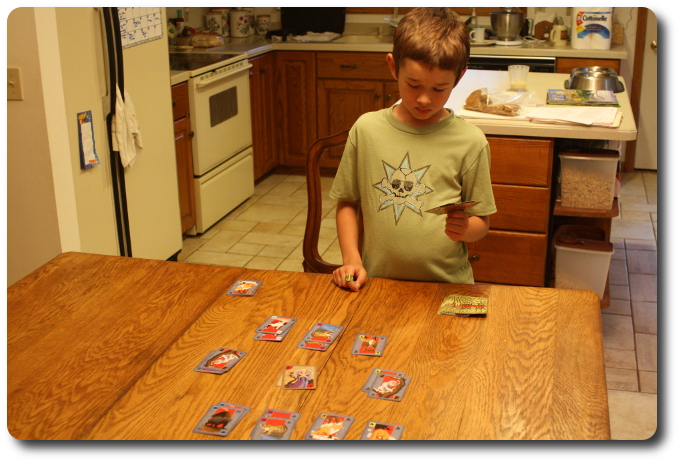
My little geek ponders his next move for a moment while I quickly take a picture
The Parent Geeks didn’t like the fact that Tessen was a game that couldn’t be played with their Child Geeks without causing stress and hurt feelings. They got over it when they played the game with their peers. It was apparent from the start that the Parent Geeks understood the game and loved the challenge of matching Animal cards as quickly as possible to score points. All our Parent Geeks, including the non-gamers, demonstrated a solid grasp of the game and showed some excellent strategic and tactical plays using their Warrior cards. For example, one Parent Geek purposely left an opponent’s Warrior card in one of their five Animal pile locations so they could just focus on 4 Animal types and save her Warriors for later. This lead to stronger plays in later rounds. All the Parent Geeks had a great time with the game and found it to be a lot of fun. According to one Parent Geek, “This is a fast game that took my breath away. I loved it!” All the Parent Geeks approved Tessen.
The Gamer Geeks found Tessen to be an engaging 2-player game from the very start. All our Gamer Geeks found it to be an excellent example of how a small game can pack a sizable punch. According to one Gamer Geek, “I wish there were more games like this. Small, easy to play, and challenging.” But not all the Gamer Geeks were overly enthralled by it. According to one Gamer Geek, “This is a solid game, but its fault is part of its greatest strength. You are only matching animal types, collecting card sets, and temporarily halting your opponent by throwing a Warrior monkey wrench at them. I think the game is very light and would get old after a while.” Regardless of the level of love or enthusiasm the Gamer Geeks showed Tessen, they all voted to approve it. One Gamer Geek summed it up nicely when she said, “This game challenged me, made me smile, and left me wanting to play it again when I was through. That, for me, makes this an excellent game.”
Tessen is a joy to play. It’s been said many times already, but it’s worth repeating: this is a fast and engaging game. Each player starts out with the same cards, but the random draws and ability to take what your opponent discards keeps both players constantly observing, acting, and reacting throughout the entire game, round after round after round. Not once did I ever feel let down or disinterested.
Was I challenged? Certainly, but never to a point where I felt like the game was out of my control. Tessen is not a chaotic game, but it can be alarmingly fast. I knew what cards I wanted to play and acted accordingly. I always had choices to make and never felt boxed in. It can be very frustrating to have a number of your Animal pile locations locked, but Warrior cards will come up. The fact that the winner of a round loses a Warrior card is a huge game changer if you are playing very well against an opponent in a 5-round game. Without Warriors, a player is unable to keep their playing area clear or trump their opponent. As the game continues, players must make subtle changes to their strategy, keeping cards in their hand they otherwise would have discarded, and their eyes open for opportunities to slow their opponent down whenever possible. Simply excellent.
I very much enjoyed my time with Tessen and am excited by the new direction games like this are taking. We appear to be seeing the reemergence of the microgame, which could not have come at a better time. The world’s economy continues to shake underneath its own weight and family budgets are tight. Investing in large games is becoming less financially feasible for many of us. Games like Tessen, which are cheap to make and cheap to purchase, provide players an affordable means to play games with family and friends without reducing depth or intensity of play. This allows everyone to keep enjoying games and helps us save money for the important things in life, like groceries and education, without sacrificing fun or our love for the hobby. Do take a look at Tessen if you are in the market for a small game that will blow you down. Consider me a “fan”.
This game was given to Father Geek as a review copy. Father Geek was not paid, bribed, wined, dined, or threatened in vain hopes of influencing this review. Such is the statuesque and legendary integrity of Father Geek.



